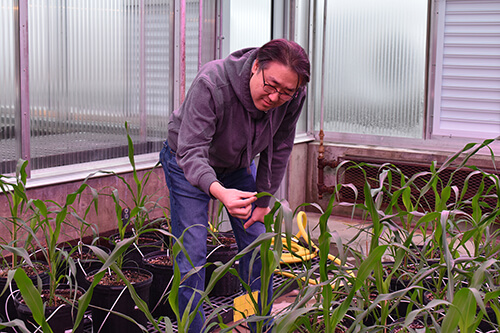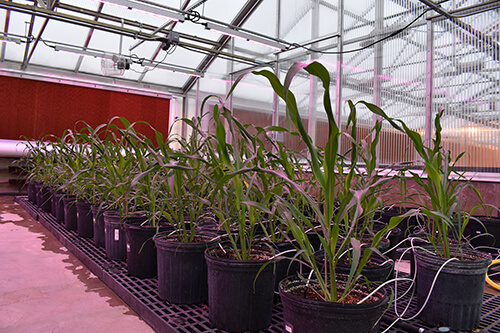Increasing sorghum's biomass by manipulating the cell wall
Article Highlights
- In a collaboration with Texas A&M, Michigan State University researchers have identified enzymes responsible for degrading a component of cell walls in sorghum called mixed-linkage glucan, or MLG.
- Sorghum is a crop with promise as a biofuel feedstock and most of the biomass used for biofuel comes from a plant’s cell walls.
- Learning more about these enzymes could thus help sorghum live up to its fullest potential.
Committing to 3 a.m. wake-up calls to run an experiment is no easy task, but the researchers in the Brandizzi lab followed through.
In a study published in The Plant Journal, researchers looked at the complex regulation of the storage of cell wall mixed-linkage glucan, or MLG, in sorghum, a crop that’s a promising biofuel feedstock. MLG is a component of the cell wall that is believed to have several biological functions, but its precise role during the vegetative growth of plants is not understood well.
“Our main goal in the Great Lakes Bioenergy Research Center is designing and generating sustainable plant feedstocks for biofuel production,” said Sang-Jin Kim, first author of the study and a researcher affiliated with the center, which is abbreviated as GLBRC.

Kim is also a fixed-term assistant professor working with Federica Brandizzi in the Michigan State University-U.S. Department of Energy Plant Research Laboratory, or PRL.
Most of the biomass of a plant comes from the cell wall. Therefore, to fulfil the need to increase plant productivity for biofuel feedstocks, the researchers are looking to manipulate the quantity and quality of cell wall biomass.
“After we looked into the sorghum cell wall compositions, we identified that mixed-linkage glucan is one of the main cell wall components in sorghum,” Kim said. “We focused on manipulating MLG, especially because the synthesis of mixed-linkage glucan is very simple.”
The researchers generated sorghum lines that accumulate more MLG than wild sorghum plants. They found that MLG accumulates in sorghum during active growth, but when the plant reaches the stage where it produces seeds, MLG starts to degrade.
“The main goal of this study is to identify and characterize the enzymes involved in MLG degradation so that we can protect high levels of MLG in the engineered sorghum from degradation,” Kim explained.
Kim and his colleagues identified three candidates of MLG hydrolase known as lichenase as potential culprits of MLG degradation in a collaboration with a lab from Texas A&M. The researchers needed to characterize how these lichenases are regulated in sorghum.

They found that the amount of MLG the plant creates depends on how much light it receives. MLG is produced during the day and degrades at night.
The greenhouses where the researchers kept their sorghum mimicked the light conditions of its natural environment. To measure the amount of MLG in the plant at the end of the nighttime degradation cycle, the researchers reported to the greenhouses by 4 a.m. to collect samples.
“Sang-Jin’s work demonstrates that improving plants is an engineering task, whose success depends on the understanding the complex biology of the organism as a whole,” said MSU Foundation Professor Federica Brandizzi, the principal investigator for the study.
“By increasing MLG overproduction and decreasing MLG degradation, it has been possible to define an effective strategy for MLG overaccumulation and therefore improve plant biomass,” Brandizzi said. “This success was worth the early wake-ups and reflects the dedication of Sang-Jin and the rest of the team to crop improvement research.”
What they found was the lichenase candidates were indeed responsible for the degradation of MLG, and the distinct expression pattern of each lichenase affected the level of MLG.
The researchers plan to next look for the exact role of MLG in sorghum and examine why MLG is made and destroyed simultaneously in the same cells. Ultimately, they aim to stack traits, including MLG overproduction and preventing MLG degradation to maximize the MLG accumulation in the biofuel feedstock.This work was funded primarily by the DOE Great Lakes Bioenergy Research Center, and acknowledges partial support from the Chemical Sciences, Geosciences and Biosciences Division, Office of Basic Energy Sciences, Office of Science, US Department of Energy; and MSU AgBioResearch.
Banner image: Potted sorghum plants used to understand mixed-linkage glucan, or MLG, accumulation in the cell wall. Credit: Kara Headley/MSU-DOE Plant Research Lab